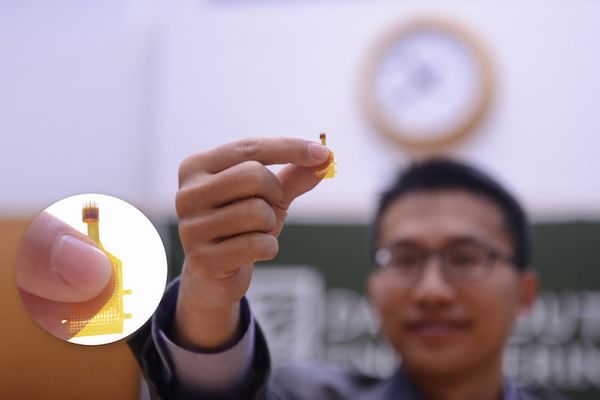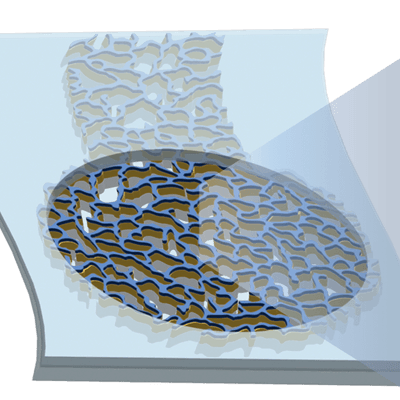- Undergraduate
Bachelor's Degrees
Bachelor of ArtsBachelor of EngineeringDual-Degree ProgramUndergraduate AdmissionsUndergraduate Experience
- Graduate
Graduate Experience
- Research
- Entrepreneurship
- Community
- About
-
Search

Professor Fang holds a 3D soft neural probe. (Photo by Kathryn Lapierre)
Overview
Professor Fang enjoys teaching and researching innovative materials, structures, and devices as solutions to address various grand challenges facing humanity, especially in biology and medicine. A particular focus in his group is to develop scalable multifunctional materials and devices, to enable convergence research to, on the one hand, respond to the complex spatiotemporal nature of the hard problems they are addressing, and to, on the other, leverage the global development of artificial intelligence. This work also involves investigating fundamental multiphysics science (mechanical, electrical, electrochemical, optical, etc.) at various surfaces and interfaces, understanding biotic-abiotic interactions, and harnessing such knowledge to engineering system-level performance. Current research concentrates on multifunctional materials and devices for large-scale soft microsystem development, all lately with an emphasis on neuroelectronics. These efforts are highly multidisciplinary, and combine expertise from materials science, device engineering, and neural engineering.
Research Interests
Neuroelectronics; electronic materials; semiconductor devices; brain-computer interfaces; neurochemical sensing
Education
BS, Materials Science and Engineering, Tsinghua University 2009
PhD, Materials Science and Engineering, University of California, Berkeley 2014
Awards
- Thayer Distinguished Research Award for Faculty, 2025
- NSF CAREER Award, 2019
- MIT Technology Review TR35, Finalist, 2017
Selected Publications
- Han X, Seo KJ, Qiang Y, Li Z, Vinnikova S, Zhong Y, Zhao X, Hao P, Wang S, Fang H. (2019) "Nanomeshed Si Nanomembranes." npj Flexible Electronics. 3:9.
- Qiang Y, Artoni P, Seo KJ, Culaclii S, Hogan V, Zhao X, Zhong Y, Han X, Wang P-M, Lo Y-K, Li Y, Patel HA, Huang Y, Sambangi A, Chu JSV, Liu W, Fagiolini M, Fang H. (2018) "Transparent Arrays of Bilayer-Nanomesh Microelectrodes for Simultaneous Electrophysiology and 2-Photon Imaging in the Brain." Science Advances. 4: eaat0626.
- Seo KJ, Qiang Y, Bilgin I, Kar S, Vinegoni C, Weissleder R, Fang H. (2017) "Transparent Electrophysiology Microelectrodes and Interconnects from Metal Nanomesh." ACS Nano. 11: 4365–4372.
- Fang H, Yu KJ, Gloschat C, Yang Z, Song E, Chiang C-H, Zhao J, Won SM, Xu S, Trumpis M, Zhong Y, Han SW, Xue Y, Xu D, Choi SW, Cauwenberghs G, Kay M, Huang Y, Viventi J, Efimov IR, Rogers JA. (2017) "Capacitively Coupled Arrays of Multiplexed Flexible Silicon Transistors for Long-Term Cardiac Electrophysiology." Nature Biomedical Engineering. 1: 0038.
- Fang H, Battaglia C, Carraro C, Nemsak S, Ozdol B, Kang JS, Bechtel HA, Desai SB, Kronast F, Unal AA, Conti G, Conlon C, Palsson GK, Martin MC, Minor AM, Fadley CS, Yablonovitch E, Maboudian R, Javey A. (2014) "Strong Interlayer Coupling in van der Waals Heterostructures Built from Single-Layer Chalcogenides." Proceedings of the National Academy of Sciences (PNAS). 111(17): 6198-6202.
- Fang H, Bechtel HA, Plis E, Martin MC, Krishna S, Yablonovitch E, Javey A. (2013) "Quantum of Optical Absorption in Two-Dimensional Semiconductors." Proceedings of the National Academy of Sciences (PNAS). 110: 11688-11691.
Patents
- Systems and methods for multiplexed amplifiers for brain computer interfaces | 12333073
News










